 Image 1 of 1
Image 1 of 1


Basingstoke Reinvented, 1800–1925: from Agricultural Town to Manufacturing Centre, edited by Jean Morrin
Basingstoke is frequently seen as a modern town, the product of the last decades of the 20th century. In reality it has a long, rich and prosperous history dating from the medieval period. This study covers the period when Basingstoke was transformed from a market town serving north-east Hampshire into a manufacturing centre producing goods for the national and international markets. Thomas Burberry, founder of the famous fashion house, established three factories in the town and developed gabardine. Wallis and Steevens expanded from a local company supplying agricultural machinery into a producer of road rollers and other machinery for the national and international markets. Thornycroft moved to Basingstoke in 1898 and produced lorries for the military and civilian markets. All relied on the railways for the supply of raw materials and the export of finished products. The study of this industrialisation contributes to a debate about how far manufacturing developed in southern towns after its initial establishment in the north of England and Scotland. This is the first in the Victoria County History’s acclaimed ‘Shorts’ series to be produced by Hobnob Press. It is published on behalf of the University of London and the VCH Hampshire Trust. June 2025, x + 184 pages, colour illustrations, paperback, £15.99, ISBN 978-1-914407-92-5
Basingstoke is frequently seen as a modern town, the product of the last decades of the 20th century. In reality it has a long, rich and prosperous history dating from the medieval period. This study covers the period when Basingstoke was transformed from a market town serving north-east Hampshire into a manufacturing centre producing goods for the national and international markets. Thomas Burberry, founder of the famous fashion house, established three factories in the town and developed gabardine. Wallis and Steevens expanded from a local company supplying agricultural machinery into a producer of road rollers and other machinery for the national and international markets. Thornycroft moved to Basingstoke in 1898 and produced lorries for the military and civilian markets. All relied on the railways for the supply of raw materials and the export of finished products. The study of this industrialisation contributes to a debate about how far manufacturing developed in southern towns after its initial establishment in the north of England and Scotland. This is the first in the Victoria County History’s acclaimed ‘Shorts’ series to be produced by Hobnob Press. It is published on behalf of the University of London and the VCH Hampshire Trust. June 2025, x + 184 pages, colour illustrations, paperback, £15.99, ISBN 978-1-914407-92-5
